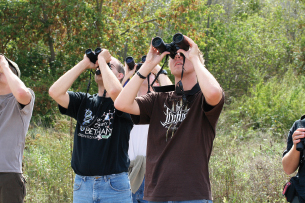By Amanda Dyslin for the Mankato Free Press on 9-22-12
The merlin was cruising up a nice little thermal, which is a tunnel of warm air that lifts birdies up into the sky without much effort on their part. And it gave a nearby sharpshinned hawk the same idea. They’ve got to conserve energy on their way down South, after all. Trouble is, merlins are feisty. They like to scrap. So the little guy decided to circle around and spice up his afternoon with a game of cat and mouse (or merlin and hawk, as it were).
Nobody else traveling by the Marvin G. Meyer Hall of Science and Mathematics at Bethany Lutheran College would have noticed this little event in the sky if not for the exclamations of five students and their bird-loving leader, biology professor Chad Heins, all of whom had their binoculars pointed to the sky.
“Merlins are feisty,” Heins said. “Merlins are some of our favorites.”
Heins has been a bird watcher for years. In 2003, he happened to be looking upward in the fall and noticed a few hawks that seemed to be migrating over campus. He suspected they were using the Minnesota River as a migratory corridor. So year after year he started counting broad-winged hawks and various other species of raptors, having seen an average of about 845 birds per year. The last couple of years other staff members have helped with the count, and last year he got a couple of students on board, too.
Ben Schultz, a communication and music major, and Zach Rinehart, another music major, decided not to limit their Bethany studies and, just for fun, they joined Heins outside Meyer Hall. The two came in on a great year. Last fall, the group counted 2,746 raptors, including turkey vultures, red-tailed hawks, bald eagles, ospreys, peregrine falcons and others.
“That was our best season ever,” Heins said.
He was glad to see even more students interested this year. He’s got about 25 on his email list, and 10 have actually joined in on the “hawk watch” so far.
The only knowledge required of them when they first joined was to be able to tell the difference between migrating raptors and other birds so they knew which to count.
“They’re learning,” Heins said. “An adult bald eagle doesn’t give them much difficulty in identifying it.”
From Aug. 15 to Dec. 15 Heins and members of the group stand outside and keep watch as often as they can. Their efforts aren’t entirely scientific, and there’s a huge margin of error. They have no way of knowing how many birds they’re missing every day when not outside, but the number is likely sky high.
Heins sends the count results to the Hawk Migration Association of North America, which compiles a daily report of migrant hawks seen at many North American hawk watch sites.
“It’s a cool opportunity for students to get out and actually do science,” Heins said.
September and October are big months for broadwinged hawks, Heins said. November quiets down quite a bit. But in December, or Eagle Days, as Heins calls it, it’ll be bald eagle counting time.
“Right now we call these the Broad-Winged Days,” Heins said.
So far this year, as of Wednesday, the group had already seen 1,368 birds, with recent days having been better than usual for sightings. Winds were out of the west at 10-15 kph Wednesday, so Heins and students Schultz, Rinehart, Alex Oldenburg, Becky Riediger and Daniel Halvorson weren’t expecting a day like Monday, when they recorded 699 birds. Between 1 and 2 p.m. Wednesday, they saw about 30 in a mostly blue sky.
“Cumulous clouds are a sign thermals are going on,” Halvorson said. “So it’s easier to find birds.”
With just one or two birds flying through every couple of minutes Wednesday, the students who were outside Monday couldn’t help but reminisce about the slew of broadwings they had seen, including a cluster of about 170.
“I was there for the fateful 10 minutes,” Schultz said. But it couldn’t top the day last fall when they saw 1,000 birds in a single day, Rinehart said. “That was a good day,” he said.


